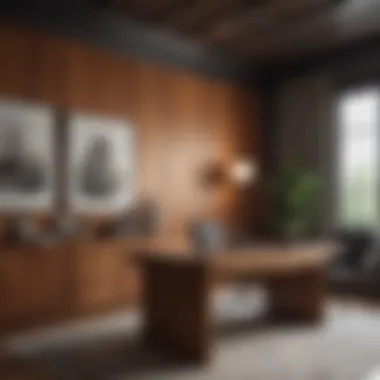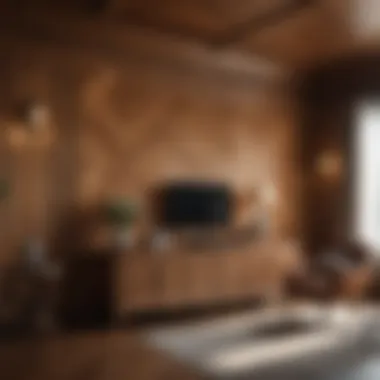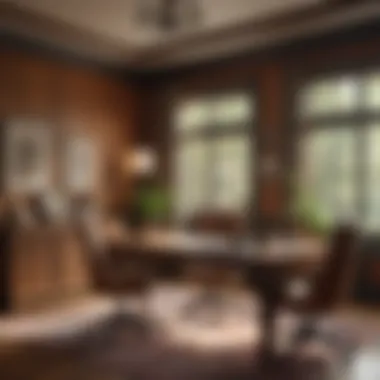Wood Paneling in Home Offices: Benefits and Tips


Intro
Creating a home office can sometimes feel like solving a riddle. What can I do to make it not only functional but also a space where I enjoy spending time? Wood paneling might just be the answer. The right wood paneling doesn’t just dress up a space; it transforms an office into a sanctuary, marrying form and function. This guide takes a closer look at how to successfully navigate the world of wood paneling to enhance your home office.
Understanding the materials, techniques, and benefits of wood paneling is vital for anyone looking to elevate their workspace. Whether you are an avid DIYer or just starting out, this comprehensive guide will equip you with everything you need to know.
Before getting your hands dirty, let's first outline the materials you'll require. We'll delve into each step of the installation process, emphasizing the finer details so everything is as clear as day. Overcoming any little bumps in the road with troubleshooting tips we'll throw in for good measure keeps things rolling smoothly.
Let’s get started.
Prelims to Wood Paneling
Wood paneling has made a significant resurgence in home office design, acting as both a functional and an aesthetic element that enhances the work environment. In this article, we explore how wood paneling can redefine a workspace, bringing not just beauty, but also a sense of warmth and familiarity. When managed well, it can even support productivity, making it a worthwhile investment for anyone looking to create an inspiring office.
Defining Wood Paneling
Wood paneling is basically boards or sheets of wood that are adhered to walls or ceilings to create a decorative finish. It can vary greatly in style, from smooth, sleek finishes to rich, textured surfaces that evoke a particular ambiance. What sets wood paneling apart from traditional painting or wallpapering is its inherent aesthetic, which conveys a sense of craftsmanship and quality. Moreover, its versatility allows it to fit seamlessly within any design scheme, whether rustic, modern, or somewhere in between.
The options for wood paneling are almost endless; you can choose solid wood for a more premium feel or opt for engineered options that offer both durability and affordability. Each type provides unique characteristics that contribute to the overall atmosphere of a space.
Historical Context
To truly appreciate wood paneling, one must look back at its storied past. Though today’s homeowners might view it primarily as a trendy decorative choice, wood paneling has been a part of architectural history for centuries. Originally, in medieval Europe, wooden panels were used to insulate homes from the cold and create warmth in otherwise drafty structures.
As time went on, particularly during the Renaissance, wood paneling evolved to become a sign of wealth and sophistication. Grand homes featured intricately carved wooden panels, showcasing the craftsmanship of the time. Moving into the 20th century, wood paneling found its way into domestic interiors, evolving from the heavy, dark timbers of the past to the lighter, more streamlined designs that resonate with contemporary tastes.
Today, wood paneling serves not just as a decorative element, but as a way to add character and a sense of history to otherwise mundane spaces. The revival of this timeless material highlights its sustainable and eco-friendly attributes, which align well with the values of many modern homeowners.
"With each plank of wood, stories are woven into the walls, transforming mere structures into homes filled with warmth and depth."
As we move through this guide, we will delve deeper into the various types of wood paneling available, their practical benefits, and how they can affect mood and productivity in your home office. Whether you're renovating an existing space or starting fresh, wood paneling holds the promise of transforming your workspace into something truly special.
Types of Wood Paneling
When considering wood paneling for a home office, understanding the various types available is fundamental. Each category presents its own set of attributes, price points, and applications, allowing homeowners to tailor their choices based on specific needs and style preferences. The type of wood paneling not only influences the aesthetics but also impacts factors like durability, insulation, and maintenance. With that said, let’s unpack the three primary types of wood paneling: solid wood panels, plywood and composite panels, and engineered wood products.
Solid Wood Panels
Solid wood panels are the epitome of elegance and longevity. Made from a single piece of lumber, these panels exude a richness that can elevate any space. What sets them apart is their robustness; solid wood can resist wear and tear quite well, which is invaluable in a bustling home office where materials might face more than average use.
- Aesthetic Appeal: The natural grains and textures of solid wood can lend warmth and a touch of sophistication that can help create a welcoming workspace.
- Variety: Wood species like oak, cherry, or walnut can bring different tones and look to your office. For instance, a rich walnut finish might resonate with traditional interiors, while lighter oak suits a more modern design.
- Fitting and Cutting: Solid wood panels can be custom-fitted to your space, ensuring a snug and polished look that helps prevent issues like warping.
However, solid wood is not without its drawbacks. It can be significantly more expensive than other types and may require more maintenance over time. If you choose this route, it is best to keep these panels properly sealed to protect against moisture.
Plywood and Composite Panels
Plywood and composite panels are excellent alternatives to solid wood, combining practicality with a pleasing aesthetic. Plywood is made up of several layers of thin sheets of wood, pressed together and glued. This gives it versatility.
- Cost-Effective: Generally, plywood and composites tend to be easier on the wallet compared to solid wood, making them a feasible option for those on a budget.
- Variety in Finishes: Available in a range of finishes, these panels can mimic the look of more expensive woods or come in unique styles.
- Ease of Installation: As plywood comes in standard sizes, it can be easier and quicker to install, which can save you both time and effort during your home office makeover.
On the flip side, they're typically less durable than solid wood and may not offer the same long-term aesthetic appeal. You might find they require more frequent replacements or repairs depending on wear and tear.
Engineered Wood Products
Lastly, engineered wood products present a modern solution for wood paneling in home offices. Comprising layers of real wood combined with other materials, these panels deliver strength, stability, and style.
- Sustainability: Engineered products often use less natural wood and can be more environmentally friendly than solid wood options.
- Moisture Resistance: The cross-layered structure helps with stability, making them less prone to issues like warping or splitting under humidity changes, ideal for varying climates.
- Wide Availability: From laminate finishes to high-density fiberboard, engineered wood products come in numerous variations. This allows a flexibility in design, accommodating both casual and professional settings.


"The right wood paneling can make a world of difference in how one perceives their workspace, affecting both appearance and functionality."
Ultimately, whether you opt for solid, plywood, or engineered wood products, ensure it aligns with your aesthetic vision and practicality requirements.
Design Considerations
When it comes to creating an effective home office, the design choices are not just about aesthetics but also function. Wood paneling can significantly affect the overall ambiance, functionality, and aesthetic of your workspace. The right design touches can channel your creativity, stimulate productivity, and provide a comforting environment to make tasks feel less daunting. Understanding the various elements that tie into the design considerations is crucial.
Color and Finish Options
Choosing the right color and finish for wood paneling can transform the atmosphere of your home office. Lighter shades, such as maple or birch, can make a room feel airy and spacious. On the flip side, darker woods like walnut or mahogany often imbue a sense of coziness and sophistication.
When picking a finish, tie it back to your personal style. A glossy finish can add a touch of modernity, while a matte finish often results in a more rustic, homey feel. Here's a quick rundown of considerations:
- Personal Preference: What colors resonate with you? Do you prefer vibrant or muted tones?
- Impact of Light: How does natural and artificial light play on different finishes?
- Durability Needs: High-traffic areas might need tougher finishes that are easy to clean.
Tip: Before settling on a finish, test samples on your walls to see how they look throughout the day.
Texture Variations
Incorporating texture into wood paneling can add dimension and visual interest. Smooth finishes shout contemporary style, while rough-hewn surfaces exude rustic warmth. Consider the following aspects:
- Grain Visibility: Types of wood have distinct grains that can either stand out or blend into the background. Open-grained woods like oak create a bold statement, while closed-grained woods like cherry give a more understated appearance.
- Paneling Styles: From shiplap to tongue-and-groove, each style presents a different texture that can significantly influence the feel of the room.
- Layering Textures: Consider mixing textured woods with flat surfaces or even different materials like textiles to enhance the overall design.
"Texture isn’t just for aesthetics—it impacts how a space feels emotionally. A tactile environment will always prompt deeper engagement."
Integration with Existing Decor
When you're thinking about wood paneling, consideration also extends to how it fits with what you already have in your home office. Integration matters, as it can unify the overall look without being overpowering. Here are some points to keep in mind:
- Color Harmony: Ensure your wood paneling complements or contrasts effectively with your existing color palette.
- Balance with Furniture: Think about your desk, shelves, and additional furniture. Will they mesh with your chosen paneling?
- Accent Pieces: Perhaps you want to highlight certain pieces like artwork or plants. Wood paneling can act as a backdrop that can either bring out these features or overshadow them.
In summary, the design choices around wood paneling can amplify the effectiveness of your home office. Their impact stretches far and wide, from the immediate visual appeal to deeper psychological influences. Attuned choices can comfort or invigorate, making your workspace a true reflection of your style and needs.
Functional Benefits of Wood Paneling
When it comes to setting up a home office, the environment plays a crucial role in productivity and comfort. Wood paneling isn’t just about aesthetics; it comes with a set of functional benefits that can significantly enhance your workspace. These benefits range from acoustic insulation to thermal comfort and long-lasting durability. Let’s delve into each of these elements to understand their importance.
Acoustic Properties
In many homes, peace and quiet can be hard to come by, especially if you share your space with family or live in a noisy neighborhood. Wood paneling offers impressive acoustic properties. Its density absorbs sound, which can help minimize distractions.
Research shows that environments designed with wood help reduce echo and provide a more soothing backdrop for concentration. Unlike bare walls, which can bounce sound around, wood can effectively dampen noise, creating a calm workspace conducive to focus and creativity.
"Sound is the invisible force that can impact your productivity profoundly. A quieter home office translates to more effective work hours."
Thermal Insulation
You might not think of wood as a temperature regulator, but it is. Wood has natural insulation properties that can keep your workspace cozy during cold months while also keeping it cooler in summer. This quality speaks volumes for energy efficiency, as a well-insulated room can decrease your reliance on heating or air conditioning. Often, the materials used on walls in typical constructions lack this functionality, leading to a more uncomfortable work setting.
By investing in wood paneling, not only are you enhancing the visual appeal of your home office, but you’re also improving its climate control, which can lead to a more enjoyable working experience.
Durability and Longevity
Wood paneling isn’t just a passing fad; it stands the test of time due to its inherent durability. Supported by its natural strength, wood can resist wear and tear better than many other materials. When properly maintained, wood panels can serve you well for decades. This longevity saves on costs over time—no need for frequent replacements or repairs.
Incorporating hardwood or even durable engineered wood can resist scratching and denting, giving your workspace a polished and enduring look. Plus, their robust nature means they can handle the demands of daily life, including the occasional bump from a chair or a stray book hitting the wall.
Psychological Impacts of Wood Paneling


In the realm of home office design, the psychological impacts of wood paneling are often underestimated. Yet, creating a workspace that is not only functional, but also conducive to a positive mental state can significantly enhance productivity and creativity. Wood paneling, with its tactile characteristics and organic warmth, fosters an environment that resonates with comfort and engagement. Thus, exploring these impacts allows for a deeper understanding of how to curate a personal workspace that nurtures well-being.
Influence on Mood and Focus
The materials that surround us have a powerful effect on our mood and focus. Wood paneling has a unique ability to create a welcoming, warm atmosphere, which can uplift spirits and encourage concentration. A study conducted at a university suggested that individuals exposed to wooden environments reported feeling more relaxed and less stressed, as compared to those in sterile, modern designs.
This warmth often translates to better productivity. When a person feels good in their space, their mental clarity improves. Personal touches, like a unique wood grain or a rich finish, can further enhance the aesthetics, allowing the workspace to feel like a personal sanctuary rather than just an office.
"The beauty of wood paneling lies in its natural variations; each piece tells its own story, creating a unique atmosphere tailored to its occupants."
Connection to Nature (Biophilic Design)
Biophilic design underscores the human connection to nature, emphasizing that environments mimicking the organic world can lead to enhanced well-being. Wood paneling exemplifies this principle. The rich textures and natural patterns provide the illusion of being outdoors, effectively integrating nature into the workspace.
Having wood, a natural element, in your office can create a sense of tranquility and reduce anxiety levels. Trees, woods, and natural landscapes have long been associated with peace. This connection to nature not only improves the aesthetic appeal of the area but also encourages creativity and fresh ideas.
Creating a Calming Environment
In an age where stress and distractions are rampant, a calming environment becomes crucial especially in a working space. Wood paneling helps in achieving this through its textures, colors, and natural patterns. Soft browns, deep oranges, or even cooler tones can invoke a sense of calmness that is hard to replicate with other materials.
Regular maintenance and thoughtful design can further enhance the calming effect. For instance, arranging the paneling to complement natural light or incorporating live plants can amplify the peaceful ambiance. Minimalist decorations combined with wood's natural beauty can create a serene space where one can focus on tasks without the usual disruption of noise or chaos.
The integration of wood in home offices not just elevates design; it also plays a pivotal role in shaping our psychological response to our work environments. By understanding these factors, housewives and homeowners can make informed decisions to improve their workspaces.
All in all, thoughtfully incorporating wood paneling into your home office not only beautifies the space but also enhances mood, fosters a connection to nature, and promotes a calming environment, leading to a productive and enjoyable workspace.
Installation Process
Wood paneling transforms spaces in many ways, turning an ordinary home office into a stylish and functional workspace. However, getting to that ideal look doesn't just happen overnight; the installation process is crucial for ensuring that your wood paneling not only looks good but lasts a long time too. Proper installation helps to avoid future headaches, saving you time and money in repairs or adjustments later on. Understanding the steps necessary for installation allows the homeowner to appreciate the work that goes into making a house feel like a home.
Preparation and Planning
Before you pick up a single tool, planning is essential. Without a clear blueprint, it's like setting sail without a map—it could lead to trouble. First, assess the space:
- Measure the dimensions carefully. You want to know exactly how much wood you'll need to avoid unnecessary trips to the store.
- Consider the layout of your office. Decide where paneling will go and if you will cover the entire wall or just a part.
- Choose the right wood type. Not every wood works the same. Think about your office’s style and functionality.
In addition to these steps, plan for any necessary permits if you live in a region where they are required for renovations.
Tools and Materials Required
Gathering the right tools and materials is half the battle won. Here’s a comprehensive list to get you started:
- Tools:
- Materials:
- Circular saw or hand saw for cutting the panels.
- Level to ensure everything is straight.
- Nail gun or hammer for fastening.
- Measuring tape and square for accuracy.
- Safety gear: goggles and ear protection.
- Wood panels (choose based on your style and budget).
- Adhesive for extra hold, if necessary.
- Primer and paint, if you wish to customize the look.
- Backer board or furring strips, especially for uneven walls.
Being fully equipped keeps the momentum steady during installation. You don't want to stop halfway through because you’re missing a tool.
Step-by-Step Installation Guide
With all your ducks in a row, you’re ready to embark on the installation journey. Follow these steps closely:
- Prep the Wall: Remove any existing wall coverings, nails, or debris. Clean the surface to ensure a secure bond.
- Install Furring Strips (if necessary): For uneven walls, attaching furring strips will create a smooth base for your wood panels. Install them vertically, spacing them about 16 inches apart.
- Cut Panels to Size: Using your measurements, cut each wood panel to fit the desired areas. A circular saw is best for this. Always double-check your measurements before cutting.
- Attach Panels: Start from the bottom and work your way up. Apply adhesive to the wall and press the panel into place, ensuring everything is level. Use nails or a nail gun to secure the panels further.
- Fill Gaps: After the panels are up, check for gaps. Use wood filler or caulk to smooth out areas where the panels meet.
- Finish Touches: Sand down rough edges and apply a finish or paint if desired. This will not only enhance the look but also help protect the wood.
"Proper preparation equals a smooth sailing installation; don’t underestimate the importance of foundational work."


By taking the time to carefully prepare, gather your tools, and follow a logical, step-by-step process, you’ll set yourself up for success with your wood paneling. What once seemed daunting can become a manageable project that leaves you with the lovely home office of your dreams.
Maintenance of Wood Paneling
Keeping wood paneling in prime condition is crucial for any home office. It not only ensures the longevity of your investment but also helps maintain the aesthetic appeal that comes with wood's natural beauty. Regular maintenance can prevent issues that may arise over time, such as fading, warping, or damage from insects. Given the integral role of wood paneling in creating a cozy and productive workspace, understanding the aspects of effective care is key.
Cleaning Techniques
The cleaning of wood paneling shouldn't feel like a daunting chore. A gentle touch can go a long way. Depending on the type of wood you have, the cleaning methods can vary but should always focus on avoiding harsh chemicals that could damage the finish.
- Dusting: Start with a microfiber cloth or a duster to remove dust and cobwebs. This basic step should be a weekly ritual to maintain the paneling's appearance.
- Wipe Down: For deeper cleaning, use a solution of mild soap and warm water. Dampen a cloth—not soaking it—and gently wipe the surface. This helps in keeping the wood looking fresh without saturating it.
- Avoid Excess Moisture: After cleaning, ensure no moisture is left on the surface, as pooling can cause wood to swell or warp.
- Conditioning: Periodically, consider using a wood conditioner to restore moisture and keep the panels looking vibrant. This will help in maintaining the natural glow of the wood.
Repairing Damages
Inevitably, wood paneling might face its share of wear and tear. Whether it’s from heavy furniture or general usage, knowing how to tackle repairs can save you significant time and money.
- Scratches and Dents: Minor blemishes can often be fixed with a touch-up marker that matches your paneling. For deeper scratches, a mixture of vinegar and olive oil can sometimes do the trick; apply gently and buff it in.
- Cupping and Warping: If the wood panels have begun to warp, humid conditions might be the culprit. A dehumidifier can help if the issue is persistent. In severe cases, you might need to carefully pry off the warped piece and replace it.
- Water Damage: For stains or damage from water, sand the affected area lightly to refinish it. Be cautious and avoid going too deep, as this can alter the entirety of the paneling.
Repainting and Refinishing
Repainting or refinishing wood paneling can dramatically alter the look of your home office. It’s like giving it a new lease of life without the need for replacement. However, choosing to do this should be approached with a bit of planning.
- Choosing the Right Paint: If you decide to paint, pay attention to the kind of paint you use; a semi-gloss or satin finish will stand up better to wear and provide an elegant look.
- Prepping the Surface: Proper preparation is half the battle. Clean the surfaces thoroughly and sand them to help the paint adhere better.
- Finishing Touches: After painting, consider sealing the panels with a protective finish to ensure durability against scratches and stains.
A well-kept wood paneling not only enhances the beauty of your home office but also contributes to a productive and inspiring work atmosphere.
Keeping up with these maintenance strategies fosters not only a prolonged lifespan for your panels but also a workspace that impresses and inspires creativity.
Alternatives to Wood Paneling
When considering how best to decorate a home office, wood paneling often comes to mind as a classic and timeless option. However, it is crucial to explore other materials that can also enhance the workspace’s ambiance and functionality. This section delves into some alternatives to wood paneling that can suit various styles and budgets. Knowing these options gives homeowners the freedom to select what aligns best with their vision and needs.
Vinyl and Laminate Options
Vinyl and laminate materials are rising stars in the realm of home office aesthetics. Many homeowners are turning to these options due to their affordability, durability, and ease of maintenance. Unlike solid wood, which can sting the wallet, vinyl and laminate replicate the look of wood without the hefty price tag. Here are key considerations:
- Cost-Effective: Compared to real wood, vinyl and laminate can save a chunk of change, making them attractive to budget-conscious decorators.
- Variety of Designs: These materials come in countless styles, colors, and textures, allowing one to find the perfect match for any decor. They can mimic everything from rustic oak to sleek mahogany.
- Resilience: Vinyl, in particular, is waterproof and resistant to scratches, making it suitable for high-traffic areas. This feature ensures that your home office remains pristine over time.
However, some will find vinyl and laminate less appealing due to slight differences in texture and warmth compared to natural wood. While they can handle wear better than wood, they may not possess the same character and charm. Still, these materials offer a practical solution that can complement any office design.
Painted Walls vs. Wood Paneling
The debate between painted walls and wood paneling often boils down to personal preference and desired atmosphere. Painted walls can create a clean, modern, and versatile backdrop, while wood paneling adds a touch of richness and warmth. Here’s a closer look at both:
- Flexibility in Color: With painted walls, the sky’s the limit. Homeowners can experiment with various hues and finishes—from soft pastels to bold, vibrant colors. This flexibility allows individuals to refresh the look of their space more easily than with paneling, which generally requires more effort and expense for a change.
- Installation: Painting can be simpler and quicker. Generally, all you need are some brushes, rollers, and a little elbow grease. Conversely, adding wood paneling is often more labor-intensive, demanding precise cutting and possibly professional installation, especially with solid wood panels.
- Impact on Space: Wood paneling can create a sense of depth and texture that painted walls sometimes lack. It can make a small space feel cozy or large space feel grounded. On the flip side, if you want to spacious feel, light-colored paint can help trick the eye into making a room seem bigger.
Ultimately, the choice between painted walls and wood paneling comes down to what resonates more with the individual. There’s undeniable charm in the texture of wood, yet painted walls offer a blank slate for creativity.
"Choosing the right materials for your workspace can create a transformative environment. Consider both style and function carefully."
Exploring the options of vinyl, laminate, and paint equips homeowners with valuable insights into creating their ideal home office. Each option has its merits and drawbacks, and understanding these nuances can guide them toward the right decision.
Culmination
In wrapping up our exploration into the world of wood paneling for home offices, it becomes clear that the choice of wood paneling goes beyond aesthetic appeal; it’s about creating a workspace that resonates with functionality and personality. Understanding the different types of wood paneling available helps in making educated decisions that align with both taste and practical needs. Given the importance of an inspiring work environment, it is crucial to recognize how wood paneling can significantly influence one’s productivity and well-being.
Summarizing Key Takeaways
- Aesthetic Variety: Wood paneling offers a range of design options, from classic to contemporary, allowing homeowners to tailor their spaces to their unique preferences. The natural grains and colors can subtly influence how a room feels and functions.
- Functional Benefits: Beyond looks, benefits such as sound dampening, temperature control, and longevity add immense value. When designed thoughtfully, wood panels can create environments that support concentration and comfort.
- Maintenance Matters: Knowing how to care for and maintain wood paneling ensures that it stands the test of time. Regular cleaning and occasional refinishing can keep a workspace looking fresh and inviting.
- Psychological Impact: The decision to incorporate wood elements can promote a sense of calmness and connection to nature, which is often desired in a home office setting. This connection can foster better focus and enhance overall morale during long work hours.
Future Trends in Wood Paneling Design
Looking forward, the future of wood paneling seems ripe for innovation. As sustainability gains importance, the trend is shifting toward reclaimed and sourced wood, which not only embodies an eco-friendly ethos but also tells a story.
- Smart Technology Integration: Expect to see wood paneling that incorporates technology, such as integrated lighting solutions or smart sound systems. This amalgamation of nature and tech will cater to the modern homeowner’s desire for efficiency without sacrificing style.
- Textural Innovations: More designers are experimenting with textures beyond the traditional smooth finish, incorporating deeper grooves or even layered panels that add depth. This not only heightens visual interest but also amplifies sensory experiences.
- Customization Options: Tailored wood paneling that matches personal styles, colors, and finishes will likely become more commonplace. Mass customization through 3D printing and other technologies could usher in a new era of personalized design for home offices.







